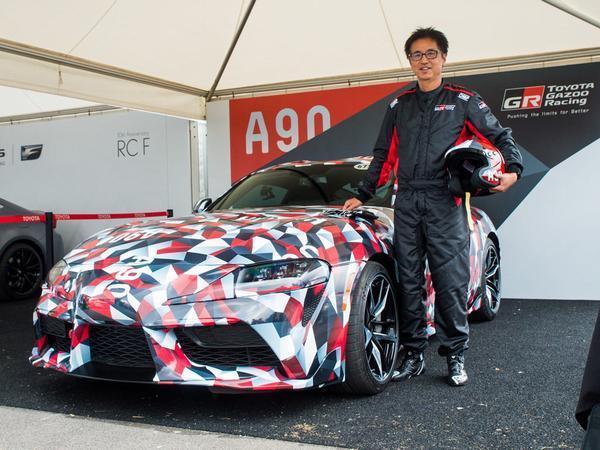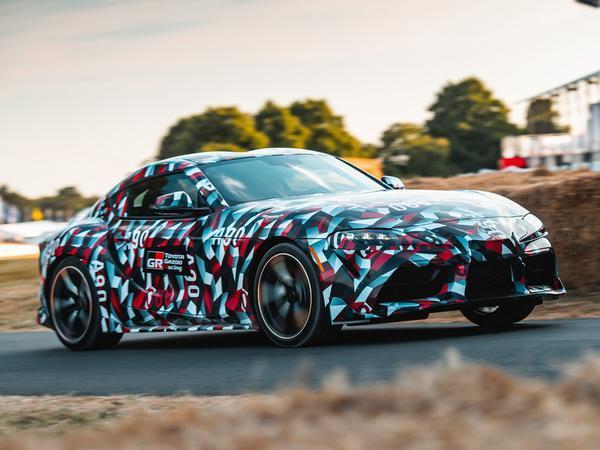Tetsuya Tada: PH Meets
With the Supra making its debut at Goodwood, we sit down with the man behind Toyota's new 390lb ft sports car

When, 15 years ago, Tetsuya Tada was asked to join Toyota's little-known 'Z division', to plan an develop a new vehicle, he assumed it would be the replacement for the Supra.
"The person who brought me in, on his recommendation, was the chief engineer for the A80 Supra, Isao Tsuzuki, and he taught me the ABC of making these cars," Tada told PH at the Goodwood Festival of Speed. "So it was interesting to hear Tsuzuki talking about the concept behind the A80, what was his intent, the emotion, the passion that he put into it, and when I was called into the Z Division I initially thought 'oh, they're going to make a new Supra'."
Turns out they weren't. Tada was called onto something else and, although he did soon work on a new sports car, that turned out to be the GT86, for which he was the chief engineer. He's also now the head of Toyota's Gazoo racing enterprise.
But when PH caught up with him, it was standing next to his latest baby: at last, the A90 Supra Concept, but for the camouflage tape as near as damnit a finished Supra, the brawny two-seat coupe which will finally return early next year.

"We still have another half a year for it to be mature engineering-wise," says Tada. "We're still working on some of the handling aspects and finer details."
What'll it be like, then? "As you can imagine, we've tested many different types of sports cars and we've gone into granular detail," Tada says. "So some cars you would turn-in OK, and as you turn it tends towards understeer, and you have many different handling aspects, but [the Supra], I can say that in all aspects of the corner we've got it completely neutral."
"And this car also is accommodating to all types of drivers. We've been driving this car on the Nurburgring, and let's say you're going into a corner, and you've over-speeded, the adjustments you make are very easy to do."
You might note, as I did, that when you ask Tada to describe what a car is like, it is not speed, performance, braking, that he talks about. He just talks about corners.

He smiles. "I have an analogy for that, actually. One of the biggest appeal points for the GT86 was the low centre of gravity, and that's the reason we have the boxer engine installed in that car. But this car, the centre of gravity is even lower than the car with a boxer engine." Which, given it has a turbocharged inline six from technical partner BMW, whose next-generation Z4 the Supra will be built alongside in Austria, is quite a feat.
There's more. "Body rigidity is twice that of the GT86. I can't disclose any figures, but the torque of this engine is on par with that which we have with the F-Series from Lexus [around 390lb ft]. But you can imagine from seeing the outside that this car is light, is compact, the wheelbase is shorter than the GT86. It's around 200-300kg lighter than the F-Series which has the same torque output."
So although no figures have been directly disclosed, between-lines reading isn't too difficult. "When we decided that we were going to do this," says Tada, "we didn't just want a revival or a rehash of what we had before. What we wanted to do was ask all the Supra fans around the world what was essential that we had in this car, and I tried to look for these conditions. And the answer was clear: inline six, turbo, front engine and rear wheel drive, and this must not change. That was clear. And when we started looking into this, prospectively, a lot of manufacturers had stopped making inline six engines. I think it was BMW which was the only one that was continuing with an inline six."
So the Supra will be a 1500kg or so two-seat coupe with a 3.0-litre BMW turbocharged engine making perhaps 350hp and 390lb ft, rear drive, a limited-slip differential, "and of course," says Tada, disclosing one number in particular, "50:50 weight distribution".

It will also be affordable. "I mentioned body rigidity is twice that of the GT86," says Tada. "That's on a par with the LFA which of course had a carbon body. And we haven't used any carbon in the body of this car; it's steel and aluminium. And that's because as long as we're introducing a sports car under the Toyota brand it must be affordable."
Does that mean, though, that a technical partnership was essential to the cost efficiency? Or just engineering purity? "First of all if I talk about the GT86 it was absolutely correct that we needed a partner to make an affordable car, and that's why we partnered with Subaru to make a feasible business case," says Tada.
"This one's different. The BRZ and GT86, as you know, almost all the parts are the same. Only the colours and the badges are different. But this one I said it was different because we both went in with our separate ideas and both ended up with what we wanted to make, irrespective of each other. So what's interesting is that there weren't any request from the Z4 to say 'can we make this common or these parts common' because that wasn't the basis for the partnership. I think what we've done - the Z4 team and our team - have developed completely independently because we didn't hear anything about their development nor they ours."
Within a few minutes Tada has to climb back into the A90 Supra and drive it up Goodwood's 1.1 mile hillclimb. "Finally I've been able to realise it the dream of Tsuzuki," says Tada, "and bring it to the world. And I feel really happy."
Gassing Station | General Gassing | Top of Page | What's New | My Stuff



